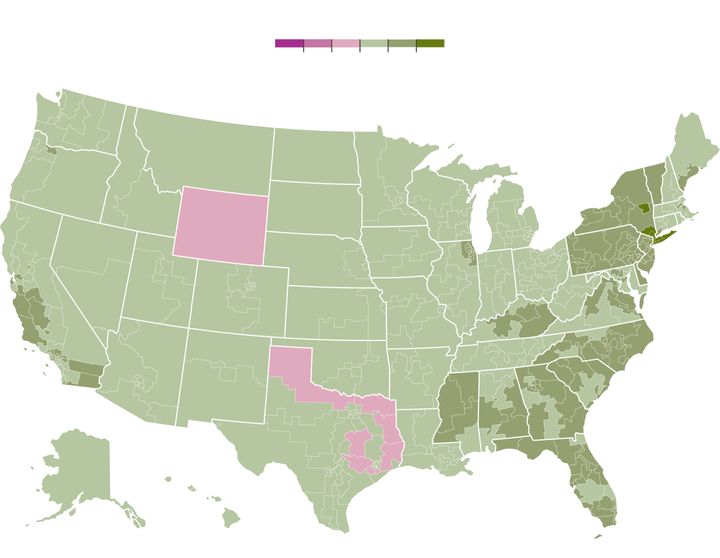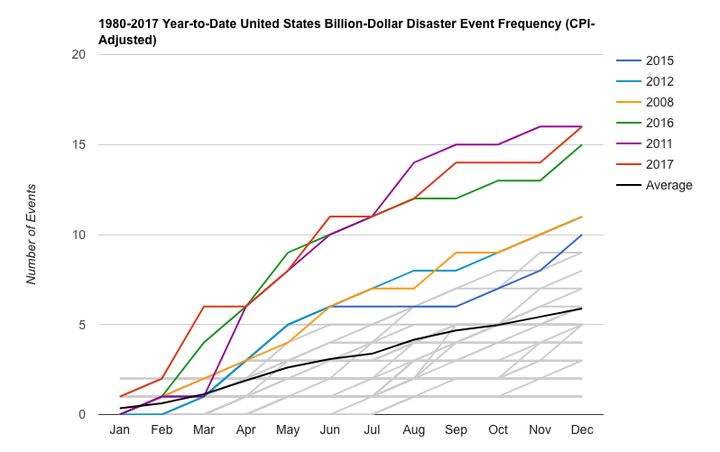
New research shows that the majority of Republicans in almost every congressional district support policies to mitigate climate change. The national average is 57%. Light green represents 50-60%, dark green more than 60%. The strongest support is in districts where climate impacts already are evident.
First in a series about the 2018 midterm election.
Republicans and Democrats are busy laying the groundwork for the midterm elections in November, foretelling another summer of campaign ads and debates. Voting without the presidency on the ballot usually does not inspire a lot of excitement. The voter turnout four years ago was the worst in 72 years. But this election will not be the typical midterm. It should be much more meaningful at both the state and national levels.
Interestingly, many of the most important issues affected by the election will not be on the printed ballot. They will be lurking between the lines. For example:
- If the midterms become a referendum on Donald Trump, we will see whether the impact trickles down to alter the current Republican domination of governorships and state legislatures.
- The outcome will determine whether Republicans or Democrats control congressional redistricting in each state after the 2020 census. In most states, legislators are in charge of redrawing the maps and governors have veto power. Gerrymandering — the time-honored practice of skewing the new districts to favor the political party in control — has been done in several states in the past, but it is being challenged in federal courts this year. In a landmark ruling earlier this month, a federal court declared that congressional districts drawn by North Carolina are unconstitutional because they were gerrymandered. Officials in many states will be looking for clear guidance from the courts on how to determine when remapping crosses the line into illegality.
- Another question will be whether voter participation overcomes voter suppression, as we saw when Alabamians elected Doug Jones to the U.S. Senate last month. Alabama is one of the states that have enacted laws and procedures designed to discourage minorities from voting. But African American voters turned out in sufficient numbers to overcome the barriers in Alabama and elect a Democrat in one of the nation’s reddest states. Since 2010, nearly half the states have enacted voter suppression laws, according to the Brennan Center for Justice. If minority voters mobilize this fall, we may see whether they can make voter suppression laws ineffective.
There is another group hoping that the fall election will be a bellwether event: the people who understand that global climate change is one of the most important issues in the country today and that it is becoming more important virtually every day that we do not do something about it.
This constituency, of which I am a member, has hoped for decades that federal, state and local elections would put people in office who would fight for clean energy, climate-change adaptation, and programs to encourage natural carbon storage in healthy soils, forests and grasslands. That finally happened with the election of Barack Obama, but all of his climate work is being undone by Donald Trump — and the current Congress is letting it happen.
In my view, candidates’ positions on climate change are more important than whether they are Republicans or Democrats. More critical is whether the people we elect to Congress acknowledge that climate change is real and are willing to work earnestly on bipartisan solutions. This will mean replacing incumbents in some cases and reelecting incumbents in others. There is a growing number of Republican incumbents in Congress who are openly acknowledging the need for climate action, but who are constrained by more conservative members of the Party.
This year, it should not be unrealistic or futile to make climate change an issue. Research released last month shows that monolithic Republican resistance to climate action has started breaking down. The study analyzed Republican opinions at the level of congressional districts and found that “Pockets of Republicans, or even a plurality or majority, support some pro-climate positions” such as regulating carbon dioxide as a pollutant and investing more in renewable energy research (see map).
As we might expect, the pockets are most noticeable in districts that already are experiencing adverse climate impacts – for example, along the coasts where extreme storms and rising sea levels are happening. The study showed that in the average congressional district, 50% of Republicans acknowledge that climate change is happening although only 31% think that humans are causing it.
No one can deny, however, that the United States is being hit with unprecedented weather disasters. There were 16 mega-disasters last year (disasters that caused more than $1 billion in damages). They tied the all-time record set in 2011. They caused more than $300 billion in damages, also a record. They killed 362 Americans.
The annual average of billion-dollar weather disasters was 5.8 events between 1980 and 2017. That average has doubled to 11.6 events in the last four years. Many weather events were downright weird, another sign of a changing climate. Among the many examples were the cold front that hit the Deep South last July and the warm spell that broke records last February in Vermont.

NOAA’s data show that major weather disasters have been above average and rising steadily in the United States since 1980. Last year tied 2011 for the all-time high of 16 “billion-dollar” events.
Insofar as the fall election becomes a referendum on Donald Trump, it should reflect that his denial of climate change puts millions of Americans regardless of their politics at much greater risk of death, property damages and health problems made worse by climate change.
Climate action should be a central issue at the state level, too, where the fall elections may influence whether states and cities can keep the promises many have made to represent America in the Paris climate accord.
Finally, if the elections give Democrats control of either the Senate or the House, we will see Congress resume its responsibility to check and balance the president’s powers. As CNN political analyst Ronald Brownstein has written, “As the 2018 election year begins, one question above all is likely to shape its outcome: Will Americans vote to constrain President Donald Trump by electing a Democrat-led Congress that will challenge and resist him, or to empower the Republicans who are increasingly working in harness with him?”
Stay tuned and involved.
